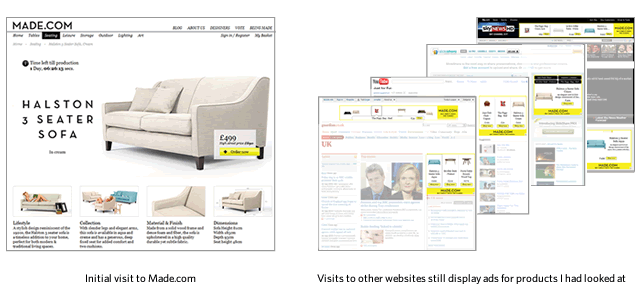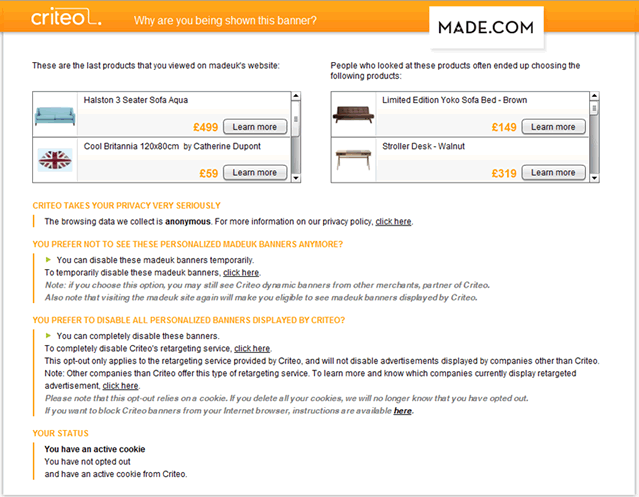Retargeting example – See larger image
As part of a casual query, I once typed in my car registration into a certain site that offers to purchase absolutely any vehicle. Scoffing at their derisory offer for my motor, I went on to live a full and happy life, and part-exchanged my car for multiples more than the site offered.
However, for the next month, almost every advert I came across on any website was a reminder of how much this company, that will acquire any auto for money, would offer for my, now crushed, car. Friends have reported similar experiences on a range of shopping sites, where your previous interest in an item can haunt you like a marketing-oriented poltergeist.
This technique, known as retargeting is an online advertising model where ecommerce websites can re-connect with past website visitors to remind them of what they had looked at with the hope of stimulating a sale. If you forgot what site you were on or what exactly you were looking for, then it can prove a useful reminder. But, if you were looking for a present for a partner, or for, ahem, a sensitive medical or entertainment item, then it might come as a bit of a shock to anyone else who uses your PC.
Whilst its an obvious benefit to businesses, with some companies offering a no-conversion, no-fee model, there may be some user experience concerns which may not be fully considered when deciding to kick-off a retargeting campaign.
High-wire balancing act, without a net
If you want to attempt this kind of approach on your site, then you need the kind of balance that would do Man on Wire proud. Most sites that engage in the activity of retargeting use a third-party service, such as TellApart or Criteo. Over time, these services have responded to the fear, uncertainty and doubt (FUD) over retargeting and improved their user communications to make it easier for a user to understand why their shopping searches are suddenly following you around the web, and to disable them.
Explaining to users why they are being shown retargeting ads
Kicking off a retargeting campaign must consider user experience
If you do decide to use such a service to promote your site, you should be aware of the potential pitfalls involved in customers feeling stalked by you. Privacy is a big concern for customers and comes up again and again in our research. If customers feel like their privacy is under attack, however small “the attack” may be, they may associate negative feelings with your brand. Rather than initiate sales and inspire revisits, you may well result in negative reviews and less repeat visits.
If you choose to use retargeting then you should enquire as to whether you can limit it to certain ranges, perhaps high value items, as no one wants to be chased across the web for a book purchase. Also, ensure a reasonable time limit is in place as well. On the whole, think about it from the user’s point of view.
Ultimately, when it comes to adding new features that could cause even mild confusion among your user-base or site visitors, remember to treat them with kid gloves. Users do not like surprises and they hate any infringements on their perceived privacy. While the marketing spiel from a retargeting company may offer the world and massive ROI, its benefits will be countered by accepting that some users may be completely turned off by retargeting and may damage brand perception.
What do you think of retargeting?



